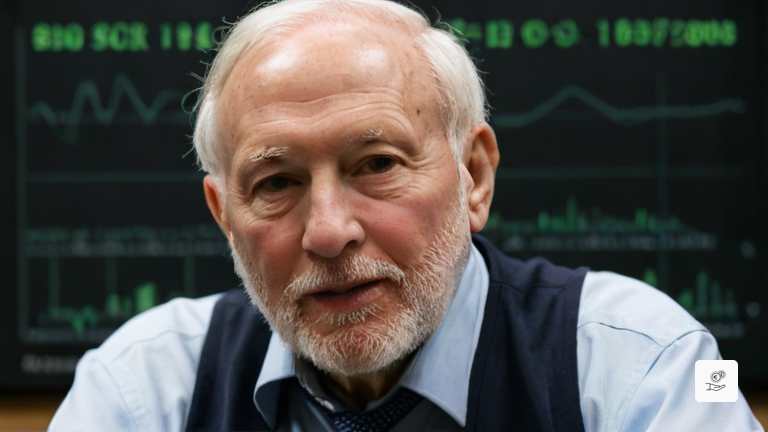The Quant King: Jim Simons’ Mathematical Journey to Investment Success

A Mathematical Mind in the Financial World
In the realm of finance, where numbers and patterns dance, there are few who have mastered the art of quantitative analysis like Jim Simons, the legendary “Quant King.” His remarkable journey from mathematician to investment titan has left an indelible mark on the financial landscape.
Early Life and Education: A Foundation in Mathematics
Born into an affluent family in Newton, Massachusetts, in 1938, Jim Simons exhibited an extraordinary aptitude for mathematics from a young age. Excelling in both academics and social circles, he pursued his passion at the prestigious Massachusetts Institute of Technology (MIT), graduating with a Bachelor’s degree in 1958.
Driven by an insatiable curiosity, Simons continued his studies at the University of California, Berkeley, where he earned his Ph.D. in Mathematics in 1962. His exceptional mathematical prowess earned him a research associate position at the Institute for Defense Analyses in Princeton, New Jersey, where he applied his skills to decode messages during the Vietnam War.
From Academia to Quantitative Investing
While teaching mathematics at Harvard University and MIT, Simons discovered the potential of his mathematical abilities in the stock market. Intrigued by the patterns and inefficiencies he observed, he launched his first hedge fund, Monemetrics, in 1978.
In 1982, Simons founded Renaissance Technologies, a hedge fund that would revolutionize quantitative trading. Leveraging advanced mathematics and computer science, Renaissance Technologies exploited market inefficiencies, generating exceptional returns for its investors.
The Medallion Fund: A Monumental Success
Renaissance Technologies’ flagship fund, the Medallion Fund, has consistently delivered extraordinary returns, averaging over 66% since its inception. This phenomenal success has earned Simons the moniker of “Quant King” and established Renaissance Technologies as a dominant force in the financial industry.
Controversies and Challenges
Despite his remarkable achievements, Simons’ career has not been without its controversies. In 2008, the SEC investigated Renaissance Technologies for alleged insider trading, raising questions about the firm’s trading strategies and the role of algorithms in financial markets.
The firm has also faced accusations of utilizing tax loopholes to avoid taxation on profits and has been embroiled in legal actions taken by former employees alleging unfair treatment or wrongful termination. However, most of these allegations have been dismissed or resolved.
Philanthropy and Social Impact
Beyond his financial success, Simons has dedicated himself to philanthropy and social causes. Together with his wife, he established the Simons Foundation in 1994, which supports research and education initiatives in mathematics, science, and autism research.
The Simons Foundation has played a pivotal role in advancing scientific research, particularly in the fields of geometry and physics, through the establishment of the Simons Center of Geometry and Physics at Stony Brook University in New York.
Simons has also invested heavily in education, supporting programs that train teachers in STEM subjects and promote math and science education in his home states of Massachusetts and New York.
Jim Simons’ Trading Strategy: A Blueprint for Success
At the heart of Jim Simons’ trading strategy lies his astute observation and understanding of mathematical modeling. He believes that markets are inherently inefficient, and these inefficiencies can be exploited through rigorous mathematical analysis.
Simons and his team of mathematicians have developed sophisticated mathematical models that can precisely predict changes in market patterns. Combined with his experience and mathematical knowledge, he has consistently outperformed his peers.
Statistical arbitrage, a technique that involves the simultaneous buying and selling of securities based on predefined statistical models, has been a cornerstone of Simons’ trading strategy. This approach has allowed him to generate reliable results and consistent profits in liquid and volatile markets.
Risk management is another key element of Simons’ success. Through diversification, hedging, and position sizing, he optimizes risk-reward ratios, ensuring the longevity of his investment strategies.
Simons’ unwavering belief in long-term investments has also contributed to his success. He advocates staying invested in the stock market over the long haul, weathering market volatility to reap the rewards of compounding returns.
Innovation and Adaptation: The Key to Longevity
Jim Simons’ success is not merely a testament to his mathematical prowess but also to his unwavering commitment to innovation and adaptation. He believes in continuously refining and developing his investment models, embracing the latest advancements in technology and mathematical techniques.
His ability to adapt and change has been instrumental in his longevity in the market, allowing him to navigate changing market conditions and maintain his competitive edge.
The Quant King’s Legacy: Inspiring a Generation
Jim Simons’ influence on the financial world is undeniable. His pioneering work in quantitative trading has revolutionized the way investors approach the stock market, inspiring a generation of young and budding investors to embrace mathematical analysis in their investment strategies.
Beyond his financial achievements, Simons’ passion for mathematics and science has left a lasting impact on the academic landscape. Through the Simons Foundation and various programs at Stony Brook University, he continues to spread the love of math and science, fostering the next generation of innovators and problem-solvers.
Jim Simons’ journey from mathematician to investment titan is a testament to the power of human ingenuity and the transformative potential of mathematical analysis. His legacy will continue to inspire and guide investors and scholars alike for generations to come.




